A wide variety of gunpowder artillery weapons were created in the medieval and early modern period.
A wide variety of gunpowder artillery weapons were created in the medieval and early modern period.
| Name | Image | Notes |
|---|---|---|
 | A long, narrow 15th–16th century cannon [1] | |
 | First recorded use in 1326, made of brass. [2] | |
| | A long-range cannon, first mentioned in 1410 [3] | |
| A type of cannon with a short barrel. [4] | ||
 | A medium cannon, smaller than a culverin | |
| A 3-pounder cannon; alternatively, an adjective to describe a lighter variant of another cannon. [5] | ||
 | A light cannon | |
| A small cannon used in the 16th and 17th centuries | ||
| A large naval cannon | ||
 | A medium cannon firing a 5 to 8 lb shot [3] | |
| | A cannon similar to a culverin [3] | |
 | A long, narrow 17th century cannon [1] |
A cannon is a large-caliber gun classified as a type of artillery, which usually launches a projectile using explosive chemical propellant. Gunpowder was the primary propellant before the invention of smokeless powder during the late 19th century. Cannons vary in gauge, effective range, mobility, rate of fire, angle of fire and firepower; different forms of cannon combine and balance these attributes in varying degrees, depending on their intended use on the battlefield. A cannon is a type of heavy artillery weapon.

Gunpowder, also commonly known as black powder to distinguish it from modern smokeless powder, is the earliest known chemical explosive. It consists of a mixture of sulfur, charcoal, and potassium nitrate (saltpeter). The sulfur and charcoal act as fuels while the saltpeter is an oxidizer. Gunpowder has been widely used as a propellant in firearms, artillery, rocketry, and pyrotechnics, including use as a blasting agent for explosives in quarrying, mining, building pipelines, tunnels, and roads.

The repeating crossbow, also known as the repeater crossbow, and the Zhuge crossbow due to its association with the Three Kingdoms-era strategist Zhuge Liang (181–234 AD), is a crossbow invented during the Warring States period in China that combined the bow spanning, bolt placing, and shooting actions into one motion.

The hand cannon, also known as the gonne or handgonne, is the first true firearm and the successor of the fire lance. It is the oldest type of small arms, as well as the most mechanically simple form of metal barrel firearms. Unlike matchlock firearms it requires direct manual external ignition through a touch hole without any form of firing mechanism. It may also be considered a forerunner of the handgun. The hand cannon was widely used in China from the 13th century onward and later throughout Eurasia in the 14th century. In 15th century Europe, the hand cannon evolved to become the matchlock arquebus, which became the first firearm to have a trigger.

During the Mongol invasions and conquests, which began under Genghis Khan in 1206–1207, the Mongol army conquered nearly all of continental Asia, including parts of the Middle East, and parts of Eastern Europe. The efforts of Mongol troops and their allies enabled the Mongol Empire to become the contemporarily largest polity in human history. Today, the former Mongol Empire remains the world's third-largest polity to have ever existed in terms of contiguous land area and the second-largest polity overall, behind only the British Empire.

The bombard is a type of cannon or mortar which was used throughout the Late Middle Ages and the early modern period. Bombards were mainly large calibre, muzzle-loading artillery pieces used during sieges to shoot round stone projectiles at the walls of enemy fortifications, enabling troops to break in. Most bombards were made of iron and used gunpowder to launch the projectiles. There are many examples of bombards, including Mons Meg, the Dardanelles Gun, and the handheld bombard.
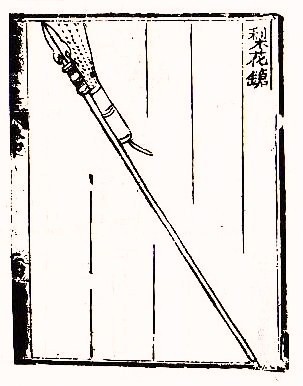
The fire lance was a gunpowder weapon and the ancestor of modern firearms. It first appeared in 10th–12th century China and was used to great effect during the Jin-Song Wars. It began as a small pyrotechnic device attached to a polearm weapon, used to gain a shock advantage at the start of a melee. As gunpowder improved, the explosive discharge was increased, and debris or pellets added, giving it some of the effects of a combination modern flamethrower and shotgun, but with a very short range, and only one shot. By the late 13th century, fire lance barrels had transitioned to metal material to better withstand the explosive blast, and the lance-point was discarded in favor of relying solely on the gunpowder blast. These became the first hand cannons.

Gunpowder artillery in the Middle Ages primarily consisted of the introduction of the cannon, large tubular firearms designed to fire a heavy projectile over a long distance. Guns, bombs, rockets and cannons were first invented in China during the Han and Song dynasties and then later spread to Europe and the Middle East during the period.
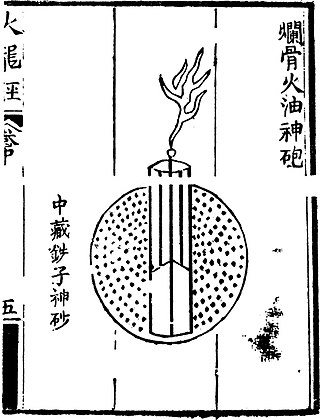
Jiao Yu was a Chinese military general, philosopher, and writer of the Yuan dynasty and early Ming dynasty under Zhu Yuanzhang, who founded the dynasty and became known as the Hongwu Emperor. He was entrusted by Zhu as a leading artillery officer for the rebel army that overthrew the Mongol Yuan dynasty, and established the Ming dynasty.
The history of cannon spans several hundred years from the 12th century to modern times. The cannon first appeared in China sometime during the 12th and 13th centuries. It was most likely developed in parallel or as an evolution of an earlier gunpowder weapon called the fire lance. The result was a projectile weapon in the shape of a cylinder that fired projectiles using the explosive pressure of gunpowder. Cannons were used for warfare by the late 13th century in the Yuan dynasty and spread throughout Eurasia in the 14th century. During the Middle Ages, large and small cannons were developed for siege and field battles. The cannon replaced prior siege weapons such as the trebuchet. After the Middle Ages, most large cannons were abandoned in favor of greater numbers of lighter, more maneuverable field artillery. New defensive fortifications such as bastions and star forts were designed specifically to better withstand artillery sieges. Cannons transformed naval warfare with its deadly firepower, allowing vessels to destroy each other from long range. As rifling became more commonplace, the accuracy of the cannon was significantly improved, and they became deadlier than ever, especially to infantry. In World War I, a considerable majority of all deaths were caused by cannons; they were also used widely in World War II. Most modern cannons are similar to those used in the Second World War, including autocannons—with the exception of naval guns, which are now significantly smaller in caliber.

The Huolongjing, also known as Huoqitu, is a Chinese military treatise compiled and edited by Jiao Yu and Liu Bowen of the early Ming dynasty (1368–1683) during the 14th century. The Huolongjing is primarily based on the text known as Huolong Shenqi Tufa, which no longer exists.
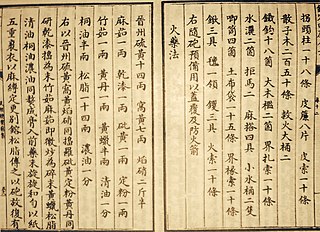
Gunpowder is the first explosive to have been developed. Popularly listed as one of the "Four Great Inventions" of China, it was invented during the late Tang dynasty while the earliest recorded chemical formula for gunpowder dates to the Song dynasty. Knowledge of gunpowder spread rapidly throughout Asia and Europe, possibly as a result of the Mongol conquests during the 13th century, with written formulas for it appearing in the Middle East between 1240 and 1280 in a treatise by Hasan al-Rammah, and in Europe by 1267 in the Opus Majus by Roger Bacon. It was employed in warfare to some effect from at least the 10th century in weapons such as fire arrows, bombs, and the fire lance before the appearance of the gun in the 13th century. While the fire lance was eventually supplanted by the gun, other gunpowder weapons such as rockets and fire arrows continued to see use in China, Korea, India, and this eventually led to its use in the Middle East, Europe, and Africa. Bombs too never ceased to develop and continued to progress into the modern day as grenades, mines, and other explosive implements. Gunpowder has also been used for non-military purposes such as fireworks for entertainment, or in explosives for mining and tunneling.
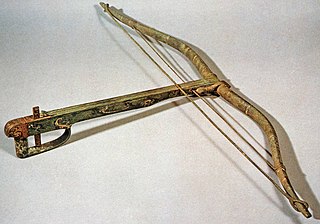
It is not clear where and when the crossbow originated, but it is believed to have appeared in China and Europe around the 7th to 5th centuries BC. In China the crossbow was one of the primary military weapons from the Warring States period until the end of the Han dynasty, when armies were composed of up to 30 to 50 percent crossbowmen. The crossbow lost much of its popularity after the fall of the Han dynasty, likely due to the rise of the more resilient heavy cavalry during the Six Dynasties. One Tang dynasty source recommends a bow to crossbow ratio of five to one as well as the utilization of the countermarch to make up for the crossbow's lack of speed. The crossbow countermarch technique was further refined in the Song dynasty, but crossbow usage in the military continued to decline after the Mongol conquest of China. Although the crossbow never regained the prominence it once had under the Han, it was never completely phased out either. Even as late as the 17th century AD, military theorists were still recommending it for wider military adoption, but production had already shifted in favour of firearms and traditional composite bows.

A gun is a device designed to propel a projectile using pressure or explosive force. The projectiles are typically solid, but can also be pressurized liquid, or gas. Solid projectiles may be free-flying or tethered. A large-caliber gun is also called a cannon.
Gunpowder weapons in the Song dynasty included fire arrows, gunpowder lit flamethrowers, soft shell bombs, hard shell iron bombs, fire lances, and possibly early cannons known as "eruptors". The eruptors, such as the "multiple bullets magazine eruptors", consisting of a tube of bronze or cast iron that was filled with about 100 lead balls, and the "flying-cloud thunderclap eruptor", were early cast-iron proto-cannons that did not include single shots that occluded the barrel. The use of proto-cannon, and other gunpowder weapons, enabled the Song dynasty to ward off its generally militarily superior enemies—the Khitan led Liao, Tangut led Western Xia, and Jurchen led Jin—until its final collapse under the onslaught of the Mongol forces of Kublai Khan and his Yuan dynasty in the late 13th century.
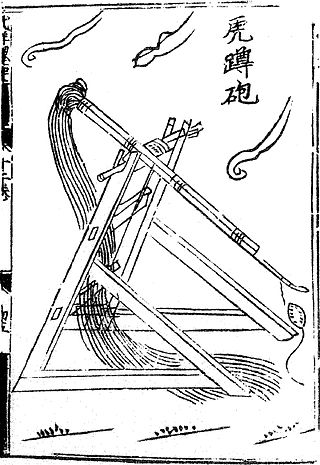
Hu dun pao (虎蹲砲) is the name of two different missile weapons in Chinese history. In the Song dynasty (960–1279), it was a trebuchet and its name is translated into English as Crouching Tiger Trebuchet; in the Ming dynasty (1368–1644), the name was given to a type of bombard and it is known in English as Crouching Tiger Cannon.
This is a timeline of the history of gunpowder and related topics such as weapons, warfare, and industrial applications. The timeline covers the history of gunpowder from the first hints of its origin as a Taoist alchemical product in China until its replacement by smokeless powder in the late 19th century.
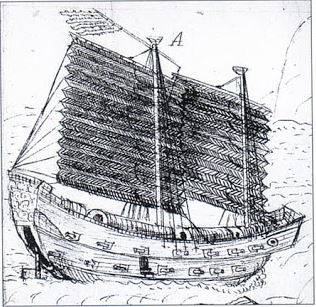
The Ming dynasty continued to improve on gunpowder weapons from the Yuan and Song dynasties as part of its military. During the early Ming period larger and more cannons were used in warfare. In the early 16th century Turkish and Portuguese breech-loading swivel guns and matchlock firearms were incorporated into the Ming arsenal. In the 17th century Dutch culverin were incorporated as well and became known as hongyipao. At the very end of the Ming dynasty, around 1642, Chinese combined European cannon designs with indigenous casting methods to create composite metal cannons that exemplified the best attributes of both iron and bronze cannons. While firearms never completely displaced the bow and arrow, by the end of the 16th century more firearms than bows were being ordered for production by the government, and no crossbows were mentioned at all.

This is an overview of Chinese siege weapons.

In the history of gunpowder there are a range of theories about the transmission of the knowledge of gunpowder and guns from Imperial China to the rest of the world following the Song, Jin and Yuan dynasties. The earliest bronze guns found in China date back to the 13th century, with archaeological and textual evidence for previous nascent gunpowder technology developed beforehand. Scholars note the scarcity of records for firearms in the Middle East prior to the mid-14th century, and in Russia before the late 14th century, yet cannons already appeared in Europe by the early 14th century. Less accepted theories include gunpowder as being independently invented in the Middle East or South Asia.